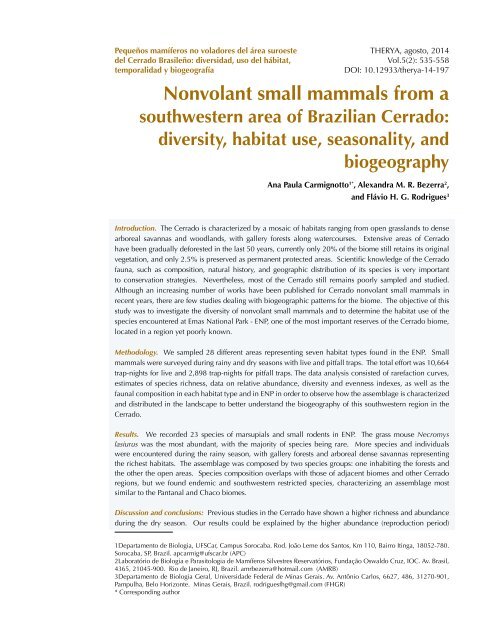therya-5_2
therya-5_2
therya-5_2
Create successful ePaper yourself
Turn your PDF publications into a flip-book with our unique Google optimized e-Paper software.
Pequeños mamíferos no voladores del área suroeste<br />
del Cerrado Brasileño: diversidad, uso del hábitat,<br />
temporalidad y biogeografía<br />
THERYA, agosto, 2014<br />
Vol.5(2): 535-558<br />
DOI: 10.12933/<strong>therya</strong>-14-197<br />
Nonvolant small mammals from a<br />
southwestern area of Brazilian Cerrado:<br />
diversity, habitat use, seasonality, and<br />
biogeography<br />
Ana Paula Carmignotto 1* , Alexandra M. R. Bezerra 2 ,<br />
and Flávio H. G. Rodrigues 3<br />
Introduction. The Cerrado is characterized by a mosaic of habitats ranging from open grasslands to dense<br />
arboreal savannas and woodlands, with gallery forests along watercourses. Extensive areas of Cerrado<br />
have been gradually deforested in the last 50 years, currently only 20% of the biome still retains its original<br />
vegetation, and only 2.5% is preserved as permanent protected areas. Scientific knowledge of the Cerrado<br />
fauna, such as composition, natural history, and geographic distribution of its species is very important<br />
to conservation strategies. Nevertheless, most of the Cerrado still remains poorly sampled and studied.<br />
Although an increasing number of works have been published for Cerrado nonvolant small mammals in<br />
recent years, there are few studies dealing with biogeographic patterns for the biome. The objective of this<br />
study was to investigate the diversity of nonvolant small mammals and to determine the habitat use of the<br />
species encountered at Emas National Park - ENP, one of the most important reserves of the Cerrado biome,<br />
located in a region yet poorly known.<br />
Methodology. We sampled 28 different areas representing seven habitat types found in the ENP. Small<br />
mammals were surveyed during rainy and dry seasons with live and pitfall traps. The total effort was 10,664<br />
trap-nights for live and 2,898 trap-nights for pitfall traps. The data analysis consisted of rarefaction curves,<br />
estimates of species richness, data on relative abundance, diversity and evenness indexes, as well as the<br />
faunal composition in each habitat type and in ENP in order to observe how the assemblage is characterized<br />
and distributed in the landscape to better understand the biogeography of this southwestern region in the<br />
Cerrado.<br />
Results. We recorded 23 species of marsupials and small rodents in ENP. The grass mouse Necromys<br />
lasiurus was the most abundant, with the majority of species being rare. More species and individuals<br />
were encountered during the rainy season, with gallery forests and arboreal dense savannas representing<br />
the richest habitats. The assemblage was composed by two species groups: one inhabiting the forests and<br />
the other the open areas. Species composition overlaps with those of adjacent biomes and other Cerrado<br />
regions, but we found endemic and southwestern restricted species, characterizing an assemblage most<br />
similar to the Pantanal and Chaco biomes.<br />
Discussion and conclusions: Previous studies in the Cerrado have shown a higher richness and abundance<br />
during the dry season. Our results could be explained by the higher abundance (reproduction period)<br />
1Departamento de Biologia, UFSCar, Campus Sorocaba. Rod. João Leme dos Santos, Km 110, Bairro Itinga, 18052-780.<br />
Sorocaba, SP, Brazil. apcarmig@ufscar.br (APC)<br />
2Laboratório de Biologia e Parasitologia de Mamíferos Silvestres Reservatórios, Fundação Oswaldo Cruz, IOC. Av. Brasil,<br />
4365, 21045-900. Rio de Janeiro, RJ, Brazil. amrbezerra@hotmail.com (AMRB)<br />
3Departamento de Biologia Geral, Universidade Federal de Minas Gerais. Av. Antônio Carlos, 6627, 486, 31270-901,<br />
Pampulha, Belo Horizonte. Minas Gerais, Brazil. rodriguesfhg@gmail.com (FHGR)<br />
* Corresponding author



